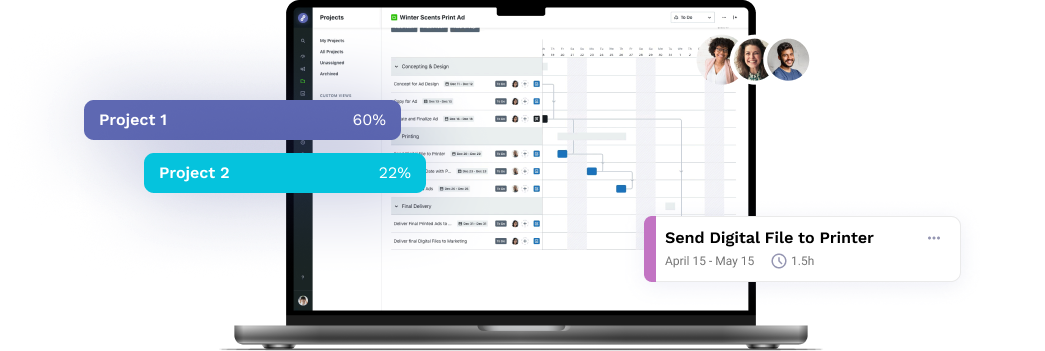
Imagine this. It’s 10 p.m. You’re cozy in your pajamas, and suddenly, a pang of dread hits. You remember: Lisa’s talent release form expired yesterday — you no longer have permission to use assets containing her image in your social marketing.
Your mind is racing… Did anyone take down the Instagram posts featuring her headshot? Or was that campaign launched on Facebook? It’s hard to remember. Your partners also had access to that digital asset collection for cross-promotion. Have they been keeping track of where they’ve posted assets?
You begin to experience a different kind of night sweats. Sleep must wait. You need to act now. Where on the world wide web do those now-unauthorized assets live???
A Historic PSA
In the 1960s, large cities in the United States enacted curfews for minors, and city leaders solicited local evening news broadcasters to remind parents to check on their children with the infamous line, “It’s 10 o’clock. Do you know where your children are?”

Homer’s ignorance is funny. Digital asset ignorance is costly.
Celebrities like Andy Warhol, Sammy Davis Jr., and Cyndi Lauper lent their voices to the cause and performed the line. The PSA made Time magazine’s “Top 10 Public Service Announcements” list and was parodied in The Simpsons episode “Bart After Dark.”
Fast forward to 2024. Parents now have help from digital babysitters to keep an eye on their children’s whereabouts. Location services are enabled on smart phones, and AirTags go inside backpacks and wallets. No matter what time it is, they know where their kids are.
Like parents, marketing teams need to keep an eye on their offspring — their creative assets. They need a digital babysitter to monitor where those assets live online because — like curfews for kids — sometimes assets need to “return home” by a certain time. Release forms expire; products and services retire; content grows uninspired.
M is for Management
“Management” is often the forgotten part of a digital asset management platform (DAM). Digital assets are saved there, but those files have a whole other life once they’re shared and released into the wild.
The first step in managing assets is developing a taxonomy of metadata, which should be easy to add, customize and search. Marketers need to index details that are specifically important to their business and processes.
For example, storing an asset’s availability dates, associated campaign name, distribution intentions, derivative files, and talent rights in its DAM records allows marketers to understand that asset’s intent as the foundation to reflect on its effectiveness.
This single source of truth also allows team members to work quickly and confidently when it’s time to deploy assets online, and speed to market is still a KPI king for marketers. Instead of consolidating fragmented data across multiple systems, marketers have the information they need attached to the asset, eliminating risk of misuse.
Management Has to Include Monitoring
The second step of managing assets is monitoring how and where assets are being consumed on external platforms to understand what is and isn’t working. These insights inform decisions about where your marketing efforts go next and what content is valuable enough to recycle.
Too many marketing teams waste budget by over-licensing — purchasing more permissions for assets like images, music, fonts, etc. than the company actually needs or will use — because their DAM technology doesn’t contribute to understanding assets’ availability or effectiveness. Their DAM doesn’t show them what’s working, what’s worth reusing, and what’s delivering a return on the creative investment.
Monitoring assets post distribution also serves as a safety measure for marketers. If teams don’t know where their assets are published online when availability dates or talent release forms expire, they can’t take them down, and they’re opening themselves up to considerable risk.
Marketing teams can’t sleep on pulling expired assets offline because ignorance is costly — financially and reputationally. You don’t want to be the team that is responsible for one of these:
- Legal battles with contracted talent over unauthorized use of protected assets result in fees and tarnished relationships.
- Old promos that point to no-longer-live landing pages deliver frustrating user experiences.
- Over-circulated content fails to catch the intended audience’s attention which results in watered-down brand awareness.
Lytho Tracks: Digital Asset Monitoring
Digital marketing’s trinity is content, distribution, and data, and your DAM needs to support all three contributors, which is why Lytho launched the latest advancement within its DAM platform — Tracks.
Using AI-based fingerprinting technology that traces assets’ journeys online, Tracks keeps a watchful eye on digital images, so you always know where your assets are, who’s using them, and how they’re being used.
Pair Tracks with Lytho DAM’s custom metadata fields, expiration warning system, and digital rights management (DRM) tools, and teams can control, automate, and optimize their marketing efforts.
Oh, the Places Your Assets Will Go
So, whatever time it is right now, do you know where your assets are? How are you babysitting your assets once they leave the DAM nest? Do you have PSA-like notifications to alert you when asset expiration dates are approaching? Can you customize and capture pertinent metadata to keep your team moving quickly and confidently? Are you tracing images’ online journeys and maintaining records of their destinations for safekeeping?
Lytho’s DAM, DRM, and asset tracking tools help marketing teams trust their content so they can rest easy.
To see Lytho Tracks in action, schedule a quick demo today.
Do you want to give yourself and your creative team more room for creative stimulation by automating the boring stuff? Lytho helps you streamline your entire workflow and harmonize all brand collateral under a single, uniform platform. Feel free to reach out to us by scheduling a demo and learning how our creative solutions can boost the effectiveness of your creative projects. We look forward to speaking with you!

Ready to simplify your creative operations and start having a little fun at work again? Schedule time to talk with us.
Let us show you how Lytho’s Creative Operations Platform helps in-house creative and marketing teams do better work, ease the stakeholder experience, and stay on brand.
Schedule a Demo